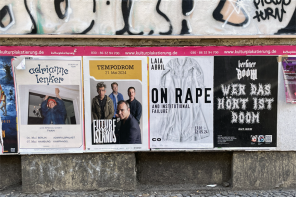They passed each other in silence. Silence was mandatory in the cold stone corridors of the House. What went on behind closed doors however, such as the heavy oak ones they were now passing (closely enough that she could feel a breath of air as Marie flitted by her), was another matter. It was morning yet, hardly time for their holy business but, even so, a faint creaking could be heard from the chamber to her right. She clutched her beads tightly as she walked. Her business was with men, but it was Marie that occupied her thoughts. She recalled the time this fellow Magdalene, and the cause of her fluttering heart, had returned from pilgrimage to Flanders. She had been wearing one of those badges… a tasty looking one depicting a sweet hair-crowned pussy borne on a litter by fat fleshy dicks. That made her think… maybe…
They did important work in Giovanna’s House. It was a tough but rewarding existence being cloistered away like that. They were doing God’s work; praying by day and saving men from the temptation that Eve had laid upon them — a temptation she knew all too well — by night.
From the orgiastic depictions of hell by Hieronymus Bosch that we are familiar with today, to the bawdy tales of Chaucer and Rabelais, or the sacredly profane phallic and vulvar badges of Medieval pilgrims, it should be of no surprise that people of the Middle Ages were licentious folk. Yet the myth persists that people of this time were prudish and bound by religious authority. To an extent, this was indeed true. Christianity played a big part in day-to-day life, but the church itself and society in general were far more sexual entities than what we might presume them to be. In fact, the church was very much aware of the importance of sexual release for the healthy functioning of the individual and society at large. Sodomy (a loose term at the time that not only applied to anal sex but to any non-procreative sexual act such as oral sex or homosexual sex) was of course frowned upon, while at the same time the fact that people engaged in such behaviour both within and without marriage was known and understood. A simple confession was all that was needed to absolve one of this sin.
In a time where patriarchy had a strong hold over societal expectations, women were employed to serve as a means of male sexual release in order to allegedly lessen incidences of rape and sexual assault (a massive, recognised problem at the time), as well as to curb tendencies the Church still seems to have a problem with, namely male homosexuality. It would seem that men could not be held accountable for their actions, which shifted the blame and burden to women. Shifting the blame/burden to female sex workers specifically was also seen as a means to preserve the “honor” and “chastity” of womenfolk in general. As we’ll soon see, sex workers were scapegoats that ensured the rest of society remained morally “clean”.
It must be noted however, that gay sex — regardless of gender — and homosexuality were not seen to be mutually exclusive. Gay sex was somewhat tolerated, in much the same way that all non-procreational sex was. Just a minor sin to be casually absolved next time you enter the confession box!
Obviously, this was a time of huge (male-driven) contradiction. So whilst people were discouraged from non-procreational sex, and male lust was deemed the fault of all women-kind, all nonetheless openly and without much judgement engaged in every imaginable sexual act in every orientation. The people (clergy and laypeople alike) of the Middle Ages enjoyed fucking as much as we do today, perhaps with less associated taboo.
One of the more interesting entities and sites of sexual release during this time were the ones implemented by and within the church itself. Civic church-ordained brothels (such as the many under the dominion of the Bishop of Winchester in Southwark) were in operation, and sex work, as I mentioned above and as lingers still today, was viewed as a “lesser evil” in society — a necessity.
In 1347, one such ‘Soul House’ or ‘Magdalene House’, was established in Avignon by Queen Giovanna I of Naples. It functioned as a convent-cum-brothel and was facilitated by sex workers who lived a pious, nun-like existence. Inspired by Queen Giovanna’s ‘Abbey’, Pope Julius II “the Terrible” founded his own brothel in Rome towards the end of the Middle Ages. It would seem that Pope Julius II, father of three illegitimate children and infamous for revelling in vice, most likely took full advantage of his Holy establishment. He died of syphilis in 1513, as I’m sure did many of his lovers. The Magdalene House’s operations continued well into the Renaissance.
The importance of the role that sex workers played during Medieval times should not be underestimated today and indeed, we can see that it was not at the time. Far from being a liberating role for women to express their sexuality freely, it was seen that they were under servitude, whether as nuns or as sex workers, of men and a patriarchal God. In the case of Giovanna’s Abbey, it seems that they were both. Even though it was the men who couldn’t help themselves but to rape and abuse women and girls, women (all women) were still seen as the cause of the issue. Too sexy. Too irresistible. The Madonna Whores. The daughters of Eve.
With the dawn of the Modern era, sex work was condemned outright. These Magdalene Houses became Magdalene Laundries — places of “reform” for “fallen women.” Institutions of persecution, abuse, murder, and neglect where the sexual woman of no moral value to society was cloistered away and forced to perform the duty of monetized cleansing for the redemption of her soul. Sexual deviance and sex work were now beyond simple forgiveness and the holy houses of sexual release became the laundries of Mary Magdalene, hidden from view to fester in unforgivable sin.
Text and Images by Jacintha Murphy
Jacintha Murphy is an Irish visual artist/writer based in Berlin. Her work is firmly rooted in an exploration of the physicality of the female body and its position in culture and society from ancient times to the present day as well as the mortality of the flesh and the regenerative, cyclical process of life/death/life.













